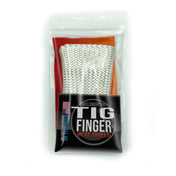This video is about Tig welding carbon steel with pulse and without pulse on a turntable for a simple project.
I have a simple tig project that requires welding 4 end caps on to a few pieces of 4" carbon steel tubing.. so I thought I would experiment a bit with pulse settings.
Stay tuned for part 2 where you will see the finished parts.
The wall thickness on the tubing is around .090" and I didnt really want to fully penetrate because that would only bring oxides into the weld and make for a wandering puddle.
When you see the actual application on these parts you will understand why I wasn't concerned with penetration.
For the first weld, I set the pulse to 50pps with 75% background current. (pulse width is fixed at 50% on the mt200).
Sometimes pulse settings can be used to provide a bit of agitation to the puddle and help it flow along with less overall heat input.
Setting the background to 75% gave a bit of a flutter but I didn't see that it had any real benefit.
Slow pulse tig settings
Next I set the pulse to 2 pps with background set to around 25% and I used a clear 8 cup.
With 2 pulses per second, I added .045" filler rod every other pulse.
It seemed to go better and heat tint was less leading me to think there was less heat input overall.
TiG welding without pulse
I like to experiment with pulse settings.
But often times, when I compare pulse to no pulse tig welding...
I come away thinking that pulse can help a little bit in a few situations but its not the be all end all in TIG welding.
I really like high speed pulse settings for welding on or near an edge.
And I like slow pulse setting of .7 to 2 pulses per second for turntable welding.
But for the most part, straight dc current without pulse gets the job done.
In a previous video, I showed welding on an edge using high speed pulse tig settings.
Welding on or near an edge is definitely one area where high speed pulse tig settings shine.
But again, the same weld can be made without using pulse.
I think using pulse settings can make certain jobs easier and occasionally even better.
But it all boils down to who is behind the welding hood.
When I worked for a large aerospace repair company we transitioned from Miller syncrowave 250 tig welders to dynasty 200 inverters with pulse capabilities.
What I learned was that the really good tig welders who were really engaged in their work saw the benefits of pulse.
And the others didn't notice any benefit.
You have to really study the effects of pulse settings to get the most out of them.








2 comments
Would you take the time out to explain Background and why it’s used on Tig Welding…?…..Thank you in advance…Eric B.
What do I need to be able to follow a good line with my mig. I have brand name helmets, more than one, and have changed and adjusted lenses. I cannot see well enough to follow an edge. Non darkening lenses are much better, no problem with stick.